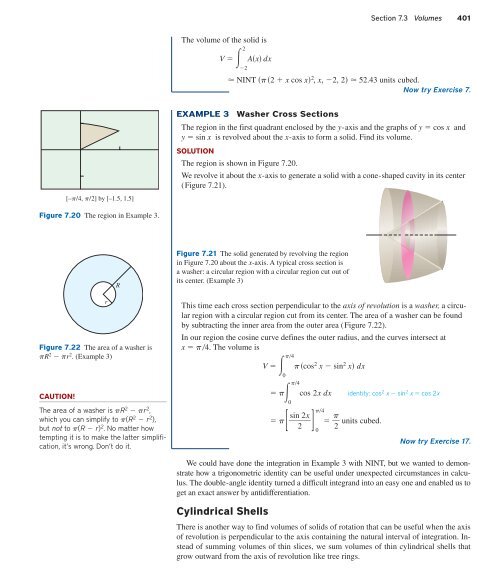Create successful ePaper yourself
Turn your PDF publications into a flip-book with our unique Google optimized e-Paper software.
Section 7.3 Volumes 401<br />
The volume of the solid is<br />
V 2<br />
2<br />
Ax dx<br />
NINT p2 x cos x 2 , x, 2, 2 52.43 units cubed.<br />
Now try Exercise 7.<br />
[–/4, /2] by [–1.5, 1.5]<br />
EXAMPLE 3<br />
Washer Cross Sections<br />
The region in the first quadrant enclosed by the y-axis and the graphs of y cos x and<br />
y sin x is revolved about the x-axis to form a solid. Find its volume.<br />
SOLUTION<br />
The region is shown in Figure 7.20.<br />
We revolve it about the x-axis to generate a solid with a cone-shaped cavity in its center<br />
(Figure 7.21).<br />
Figure 7.20 The region in Example 3.<br />
Figure 7.22 The area of a washer is<br />
pR 2 pr 2 . (Example 3)<br />
CAUTION!<br />
The area of a washer is pR 2 pr 2 ,<br />
which you can simplify to p(R 2 r 2 ),<br />
but not to p(R r) 2 . No matter how<br />
tempting it is to make the latter simplification,<br />
it’s wrong. Don’t do it.<br />
r<br />
R<br />
Figure 7.21 The solid generated by revolving the region<br />
in Figure 7.20 about the x-axis. A typical cross section is<br />
a washer: a circular region with a circular region cut out of<br />
its center. (Example 3)<br />
This time each cross section perpendicular to the axis of revolution is a washer, a circular<br />
region with a circular region cut from its center. The area of a washer can be found<br />
by subtracting the inner area from the outer area (Figure 7.22).<br />
In our region the cosine curve defines the outer radius, and the curves intersect at<br />
x p4. The volume is<br />
V p4<br />
0<br />
p p4<br />
0<br />
pcos 2 x sin 2 x dx<br />
cos 2x dx<br />
]<br />
p[ sin 2x<br />
2<br />
p4<br />
0<br />
identity: cos 2 x sin 2 x cos 2x<br />
p 2 units cubed. Now try Exercise 17.<br />
We could have done the integration in Example 3 with NINT, but we wanted to demonstrate<br />
how a trigonometric identity can be useful under unexpected circumstances in calculus.<br />
The double-angle identity turned a difficult integrand into an easy one and enabled us to<br />
get an exact answer by antidifferentiation.<br />
Cylindrical Shells<br />
There is another way to find volumes of solids of rotation that can be useful when the axis<br />
of revolution is perpendicular to the axis containing the natural interval of integration. Instead<br />
of summing volumes of thin slices, we sum volumes of thin cylindrical shells that<br />
grow outward from the axis of revolution like tree rings.












